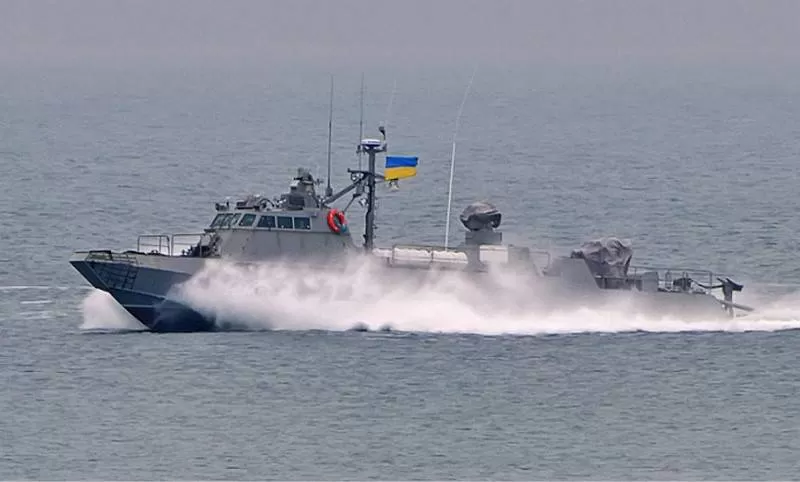
Ukrainian centaurs

Experienced assault boat DShK-01 project 58503 "Kientavr-LK" during the christening ceremony.
The resurgent Wijskowo-Morski Syły Ukrajina and the gradually modernized Wijskowo-Morski Syły Ukrajina will soon receive two new warships. “Ships” is perhaps an exaggerated term for 54-ton vessels, but decimated by the losses incurred as a result of the annexation of Crimea, and earlier by years of underfunding, the navy of our eastern neighbor is being rejuvenated by gradually strengthening its potential, which the Kiev Ministry of Defense is consistently implementing within the framework of the State Program development of weapons and military equipment until 2021.
On September 14, an experimental assault boat DShK-01 was launched in Kyiv. It is being built by the private joint-stock company PJSC "PrAT "Forge Plant on Rybalsky", until 2017 known as PJSC "PJSC "Plant Leninskaya Kuznya". The importance of this event is evidenced by the presence at the ceremony of the Secretary of the National Security and Defense Council of Ukraine Oleksandr Turchynov, the Minister of Defense General Stepan Poltorak and the Commander of the Ukrainian Navy. Igor Voronchenko, as well as military representatives of friendly countries, including the Defense Attache of the Republic of Poland, comm. Maciej Nalench. Four days later, the twin DShK-02 was quietly launched at the same plant.
Project unit 58181 "Kientavr" (Polish centaur) was developed by the Research and Design Center for the Shipbuilding Industry (NPCS) in Mikolov under the leadership of Chief Designer Sergei Krivka. The experience gained during the construction and operation of serial small artillery armored boats of project 58155 "Gyurza-M" was used (see V&T 4/2015). The initiative to develop such units for WMSU and the Special Operations Service came from the IPCK and was quickly taken over by the Department of Defense. The clientele should form an asymmetric response to the Russian threat in the area of the Black and Azov Seas and - together with the Gyurza-M - due to the simplicity of design and small dimensions, and hence high strategic mobility, allow the rapid strengthening of naval forces in almost any region .
Technical project 58181 was completed by the end of 2015, and a couple of boats were ordered under a contract signed on May 24, 2016 between the Ministry of Defense and the Lenin Forge. At that time, DPKK handed over the technical documentation of the boats to the plant, which had already built units of project 58155. Meanwhile, for unknown reasons, the plant refused further cooperation with DPKK and independently prepared the working documentation, making a number of changes to this. As a result, the project number was changed to 58503, and the symbol was changed to "Kientavr-LK" (from "Lenin's smithy"). The laying of the boat with construction numbers 01032 and 01033 took place on December 28, 2016. It is interesting that commemorative plaques (the so-called “probable boards”) with the old project number are installed on both structures.
Asymmetric response
The Kientawra idea is based on Swedish and Russian solutions - Stridsbåt 90 and 03160 Raptor design, and similarly to the prototypes, it is designed for the rapid transfer of special forces groups, reconnaissance, mine laying and combating manpower in coastal areas. The Ukrainian boat, however, is larger than them (see table), so it can carry more soldiers and carry heavier weapons. At the same time, it was possible to maintain almost the same shallow draft of the hull, which favors operations on the rivers and in the littoral. The intentions of WMSU and SSO include the use of Clients in the Sea of Azov and part of the Black Sea in the Crimean region.
The construction of the cutter is made of steel, unlike Stridsbåt and Raptor, which are made of aluminum alloys. The layout of the unit duplicates the above-mentioned solutions: in the bow there is a lowered ramp leading to the inside of the hull, then there is a crew cabin and a room for maneuvering, below them is a living room, behind them is a centrally located troop compartment that can accommodate up to 32 operators (they have the ability to access a bow ramp that provides safe access to the shore or shallow water), and the end of the hull occupies a gym. The combat and airborne compartments, as well as the engine compartment, are protected by 8 mm thick steel armor, which protects against fragments of small arms and fragments of mortar grenades and artillery shells. At the stern there is an anchor with a spire, which facilitates the exit from the shore or shallow water.
The power plant consists of two Caterpillar diesel engines with a total output of 2800 kW/3808 hp driving two Hamilton Jet engines with reverse thrusters. It was thanks to the rejection of screws (which are on Gyurzach-M) that it was possible to maintain a small immersion of the units. The aforementioned propellers were also one of the reasons for the relatively long construction of these simple units, since it was originally planned to use Rolls-Royce KaMeWa products. According to media reports, boats with a displacement of 54,5 tons should reach speeds of up to 50 knots, but a value of 35-40 knots is more likely.
